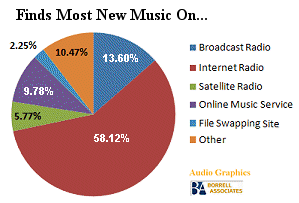 Analytics, Metrics and Music for the Radio Industry
Analytics, Metrics and Music for the Radio Industry
 An Indie Artist Pipeline to Internet Radio
An Indie Artist Pipeline to Internet Radio
 Radio Industry ROI Strategy
Radio Industry ROI Strategy
 A New Breed of Indie Artists
A New Breed of Indie Artists
Radio Industry is Missing the "New"
I'm again questioning stories that appear in radio industry trades. Those articles that deal with radio succesfully launching new products, reaching 93% of the US population weekly, and being THE place where people find new music come off as pandering to their audience's desire for reaffirmation that radio is still in the fight. Of course it is, but that's only part of the story.
There's a difference between what's reported by radio's press and what's happening online. This is obvious because you easily change the results when shifting demos, or common traits of groups, on stats that appear in radio trades.
| "These artists represent only a small portion of the new music being discovered online, and why many people under 35 don't consider the broadcast radio industry as a 'new music provider.'" |
For an example, let's take the report at Radio Ink stating "...radio is still by far the number one way consumers hear about new music. 43% say they discover music most often through radio. 13% get recommendations from friends. 8% by watching YouTube...." I'm going to show that if you ask this question of people who are not part of the general population, the reported 43% would drop considerably. And, I'm then going to show why. |
|
First, let's tackle this Radio Ink article and the picture chosen to accompany the words; I swear, it looks like me in my 1961 sixth-grade picture. Please note: Radio Ink is a good radio trade publication which often carries informative stories that I back with enthusiasm. But it's doing the radio industry a disservice by choosing to use a picture that's so old as to emphasize this AG article's title, "Radio Industry is Missing the 'New.'" (View the picture at Radio Ink, or here.) Now, let's address this claim that "43% say they discover music most often through radio." That's really depending on who's asked. In a July 2010 Audio Graphics survey of 1,043 internet radio listeners, only 13.6% claim to find "most new music" on broadcast radio. 58.1% say they find "most new music" on internet radio.  Shift the demos to only those 12-44, and it's 11.8% claiming broadcast offers most new music. Look at the 45+ crowd, and broadcast gains a little - up to 15.3%. But that's not really what I want to show you today. What follows is at the heart of this discussion; it demonstrates why people are going to web sites like YouTube to find new music. As nearly anyone can attest, hearing new songs on radio is something that happens infrequently. The redundancy of a short, rather homogenized playlist offers the same sound to nearly every radio station (of the same format). That's why I ask that you spend a few minutes on the following, to see why "new" musicians - many times with far more talent than the formula-based artists heard within the radio industry - are a major draw online. These artists are among the "new music" being uncovered on the internet. Give another 5 years, and the explosion of finding new music online is going to be so loud as to drown out the numbers that radio industry trades claim. The reason is simple: Radio continues to miss the "new." Stop #1: Kina Grannis - "In Your Arms." This music video has been viewed nearly 7.5 million times. How they made the "In Your Arms" video is approaching 1 million views. I strongly suggest viewing, at least, this video - it's among the most charming I've come across. That background is created with jelly beans!  #2: Sungha Jung appears to be about 10 years old in this video that's had nearly 12 million views. He's amazing, doing U2's "With or Without You." That's the only way to say it.  (Another of Sungha's videos, posted Nov 19, 2011, already has over 7 million views.) #3: Carlos Vamos plays Jimi Hendrix "Little Wing" in this video, now at 1.3 million views. #4: Street performer Gustavo Dal Farra is a bassist who makes his guitar do things a bass guitar should not do. At nearly 11.5 million views, he's another reason why "online" is where people are going to find new musicians. These artists represent only a small portion of the new music being discovered online, and why many people under 35 don't consider the broadcast radio industry as a "new music provider." Consider that your radio station could be listing these artists on your web site and then sending people to that site through over-the-air promotion of "new talent" now at "our site." But, my guess is you don't. Twenty years ago the radio indusry had a lock on introducing new music. Today it's locked-out most new artists in favor of assigning playlists from a central point, with artists furnished by only a few major labels. If you believe that's incorrect, here's a reality check that's simple to take: Visit YouTube Music. If you leave this YouTube page with anything but the thought that "the radio industry is not in the lead of introducing new music anymore," you are one of those thousands of people 1911 Nobel Prize Laureate in Literature, Maurice Maeterlinck spoke of when saying, "At every crossroad on the road that leads to the future, each progressive spirit is opposed by a thousand men appointed to guard the past." ...And, there's nothing that can be said which will change your mind that the radio industry is missing the "new." If you are interested in introducing new artists on your station's stream, visit Audio Graphics' "Intro to Indie Artists" sample page. It's all new music, offered to you free by indie artists looking for exposure. |











